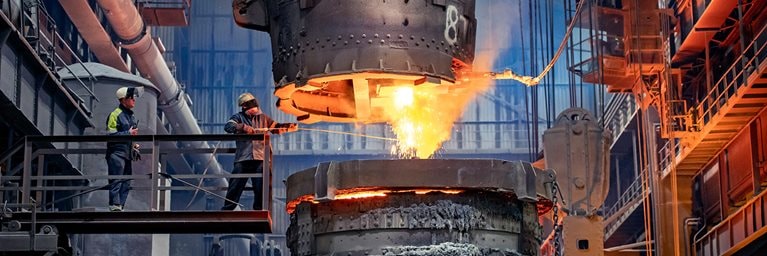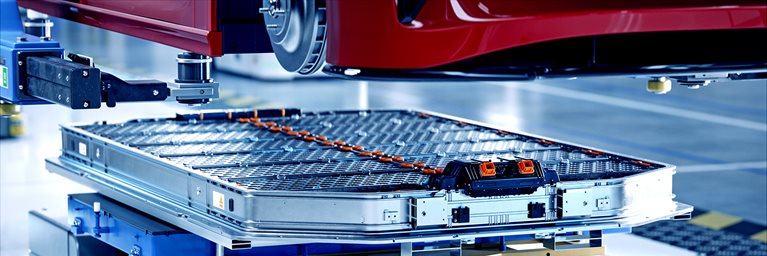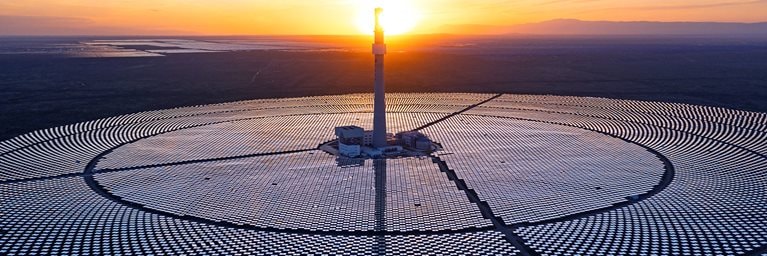The hard stuff: Navigating the physical realities of the energy transition
At a glance
- The energy transition is in its early stages, with about 10 percent of required deployment of low-emissions technologies by 2050 achieved in most areas. Optimized over centuries, today’s energy system has many advantages, but the production and consumption of energy accounts for more than 85 percent of global carbon dioxide (CO2) emissions. Creating a low-emissions system, even while expanding energy access globally, would require deploying millions of new assets. Progress has occurred in some areas, but thus far has largely been in less difficult use cases.
- Twenty-five interlinked physical challenges would need to be tackled to advance the transition. They involve developing and deploying new low-emissions technologies and entirely new supply chains and infrastructure to support them.
- About half of energy-related CO2 emissions reduction depends on addressing the most demanding physical challenges. Examples are managing power systems with a large share of variable renewables, addressing range and payload challenges in electric trucks, finding alternative heat sources and feedstocks for producing industrial materials, and deploying hydrogen and carbon capture in these and other use cases.
- The most demanding challenges share three features. First, some use cases lack established low-emissions technologies that can deliver the same performance as high-emissions ones. Second, the most demanding challenges depend on addressing other difficult ones, calling for a systemic approach. Finally, the sheer scale of the deployment required is tough, given constraints and the lack of a track record.
- Understanding these physical challenges can enable CEOs and policy makers to navigate a successful transition. They can determine where to play offense to capture viable opportunities today, where to anticipate and address bottlenecks, and how best to tackle the most demanding challenges through a blend of innovation and system reconfiguration.
Today’s energy system, encompassing both the production and consumption of energy resources, is massive and complex. The system has been optimized over centuries, is deeply embedded in the global economy, and serves billions of people, if not yet all of humanity. And it is high-performing. Energy can be dispatched relatively easily where and when it is needed because current fuels are energy-dense and easily transportable. Supply can be ramped up and down quickly.
For all its advantages, today’s system also has critical flaws. About two-thirds of energy is currently wasted. And the system generates more than 85 percent of global emissions of carbon dioxide (CO2).
Companies and countries are now engaged in an effort to transition the energy system and reduce those emissions—and to do so in just a few decades. That is a big ask. In the digital age, we have become accustomed to lightning-fast transformations. TikTok took nine months and ChatGPT only two months to gain 100 million users. But an energy system is a physical entity, and historical energy transitions have taken many decades or even centuries. Complicating the task of building a new low-emissions energy system is that it coincides with the need for it to continue to grow to expand access to energy for billions of people who still do not have it, thereby economically empowering them.
Real progress has been made, but the transition remains in its early stages. Thus far, deployment of low-emissions technologies is only at about 10 percent of the levels required by 2050 in most areas, and that has been in comparatively easy use cases. More demanding challenges are bound to emerge as the world confronts more difficult use cases across geographies.
Low-emissions technologies such as solar and wind power and electric vehicles (EVs) have advantageous properties and can be brought together to deliver high performance. But deploying them well and progressing the transition further requires understanding the physical realities of the energy transition—the “hard stuff.” Recognizing that the energy transition is first and foremost a physical transformation is a truth that can get lost in the abstraction of net-zero scenarios. But it is vital if the new energy system is to retain, or even improve on, the performance of the current one and secure an affordable, reliable, competitive path to net zero.
The observation has widely been attributed to Albert Einstein that, given an hour to solve a problem, he would spend 55 minutes defining the problem and five thinking about solutions. It is in that spirit that this research builds on the vast body of literature on the energy transition and pathways to net zero. Across seven domains, it identifies 25 significant physical challenges that must be overcome if the transition is to succeed. Three aspects stand out across these challenges: the maturity and performance of low-emissions technologies; the degree of scaling these technologies and their support infrastructure and supply chains would need as this massive energy system is transformed; and interdependencies across the different parts of the system.
Click on the tiles for summaries of 25 challenges across 7 domains
Download the full report for an in-depth review of each domain and associated physical challenges.
Seven domains of the energy system would need to be transformed, and this effort is in its early stages

Wide view image of wind turbines in the ocean with turbulent cloudy skies and an oil tanker going by in the distance.
The energy transition involves the physical transformation of seven deeply interlinked domains. The first is the power domain, which needs to reduce its own emissions and to scale dramatically to provide low-emissions energy to the three large consuming domains: mobility, industry, and buildings. The final three domains are enablers of the energy transition: raw materials, especially critical minerals; new fuels, such as hydrogen and other energy carriers; and carbon and energy reduction (see sidebar, “Why understanding the physical realities of the transition matters”).
This research primarily uses the 2023 McKinsey Achieved Commitments scenario, not as a forecast, but to understand the physical challenges to overcome. Under this scenario, billions of low-emissions assets—for instance, about one billion EVs, over 1.5 billion heat pumps, and about 35 terawatts of low-emissions power generation capacity—would need to be deployed by 2050 alongside scaling supporting infrastructure such as the grid, EV charging stations, and supply chains (Exhibit 1).

Image description:
A stacked area chart shows that primary energy consumption grew steadily from 1990 to 2022. Fossil fuels accounted for about 80 percent of the total in 2022. Other non-fossil fuels accounted for most of the rest, and variable renewable energy (VRE) had a very small but growing presence. On the right side, two line charts show energy system emissions have not started to decline, with a six percent increase from 2012 to 2022. But emissions intensity, measured in million tonnes of CO2 per exajoule of primary energy consumption, decreased by 7 percent over the same period.At the bottom, a Gantt chart shows the 2022 deployment of low-emissions technologies as a share of their needed 2050 deployment in each of 7 domains, or sectors. The 2050 deployment needs are based on the McKinsey 2023 Achieved Commitment Scenario, in which most countries reach their net-zero commitments by or before 2050. In the power sector, low-emissions installed capacity is at 8–12 percent of its needed 2050 deployment. In the mobility sector, deployment has reached three percent of its needed deployment for electric vehicles (EV) stock and 15 percent of its needed deployment for EV sales. The industry sector has reached 0–10% of its needed deployment for low-emissions production of steel and cement. The buildings sector has reached 5–7 percent of its needed deployment for heat pump stock and 9–12 percent of its needed deployment for heat pump sales. The raw materials sector has reached 10–35 percent of its needed deployment for the supply of critical minerals. The hydrogen and energy carriers sector has reached less than one percent of its needed deployment for the production of low-emissions hydrogen. Finally, the carbon and energy reduction sector has reached less than one percent of its needed deployment for CO2 capture by point-source facilities.Overall, the charts show that the energy transition is at an early stage.
End of image description.
Recent years have seen momentum on many—but not all—fronts. For instance, about 90 percent of all battery EV sales and almost 60 percent of solar and wind power capacity added was in the past five years. But overall, the transition is in its early stages. Deployment of low-emissions technologies is currently only about 10 percent of the levels required by 2050 in most domains—and largely in comparatively easy use cases.
While some areas like solar have grown rapidly, others have not. In cases such as low-emissions hydrogen, carbon capture, and low-emissions primary production (excluding recycling) of large industrial materials, less than 1 percent of required deployment by 2050 has been achieved thus far.
Abating about half of energy-related emissions depends on addressing the hardest of 25 physical challenges

Steelworkers in heat protective gear starting a glowing molten steel pour in a steelworks factory.
To progress the transition further, 25 physical challenges—defined as barriers to switching from high-emissions physical assets and processes to low-emissions ones—across the seven domains would need to be addressed (Exhibit 2).

Image description:
An hexagon chart presents 25 physical challenges that must be addressed for a successful energy transition, categorized by domain. The challenges are grouped into three levels, according to the level of difficulty of addressing them. Level one challenges require deploying established technologies that face the least physical hurdles. Level two challenges require deploying known technologies to accelerate and scale them. Level three challenges occur when technological performance gaps meet demanding use cases and the transformation is just beginning. The challenges are arranged in a honeycomb pattern. The first domain is the power sector, with six challenges: managing renewables’ variability (level 3); scaling emerging power systems (level 3); flexing power demand (level 2); securing land for renewables (level 2); connecting through grid expansion (level 2); and navigating nuclear and other clean energy (level 2). End-Use Sectors include three domains: mobility, industry, and buildings. Mobility challenges include driving battery electric vehicles (BEVs) beyond breakeven (level 1); going the distance on BEV range (level 1); loading up electric trucks (level 3); charging up EVs (level 2); and refueling aviation and shipping (level 3). The challenges in the industry domain are furnacing low-emissions steel (level 3); cementing change for construction (level 3); heating other industries (level 3); synthesizing low-emissions ammonia (level 3); cracking the challenge of plastics (level 3); synthesizing low-emissions ammonia (level 3); and heating other industries (level 2). Challenges in the buildings domain include facing the cold with heat pumps (level 1); and bracing for winter peaks (level 2). The last three domains are categorized as enablers. They are: raw materials, H2 and other energy carriers, and carbon & energy reduction. Raw materials include one challenge: unearthing critical minerals (level 2). H2 and other energy carriers include harnessing hydrogen (level 3); scaling hydrogen infrastructure (level 3); and managing biofuels footprint (level 2). Carbon and energy reduction challenges are expanding energy efficiency (level 2); capturing point-source carbon (level 3); and capturing atmospheric carbon (level 3).
End of image description.
Some challenges are harder to address than others, and they have been categorized into three levels of difficulty based on technological performance, interdependencies across different challenges, and scaling needs:
Three Level 1 challenges require progress in deploying established technologies and face the least physical hurdles.
Ten Level 2 challenges require the deployment of known technologies to accelerate, and associated infrastructure and inputs to be scaled.
Twelve Level 3 challenges have technological performance gaps and interdependencies, and are early in their transformation.
Eliminating between 40 and 60 percent of the energy system’s CO2 emissions depends on addressing Level 3 challenges (Exhibit 3).

Image description:
A donut chart shows the share of direct and indirect emissions in 2022 that are associated with Level 3 challenges, which are defined as the most challenging physical aspects of the energy transition. The chart shows that Level three challenges account for 40–60 percent of total emissions from the energy system. The chart further shows that the power domain is responsible for about 40 percent of the emissions associated with Level three challenges, while mobility and industry contribute about 20 percent and 40 percent, respectively. The challenge levels are based on the McKinsey 2023 Achieved Commitment Scenario, in which most countries reach their net-zero commitments by or before 2050.
End of image description.
Download the full report for an in-depth review of each domain and associated physical challenges.
Each domain faces physical challenges

Image of an EV battery pack being assembled under an electric car on a production line, inside a modern factory.
The research looks at physical challenges in seven domains (see sidebar, “Scope and methodology”). Click on each domain name to go to the chapter in the full report.
- Power. Overall, low-emissions power generation capacity would have to increase about ten times by 2050. There are two Level 3 challenges: managing variability in the power system as solar and wind generate a greater share of power, and doing so in emerging power systems that need to grow particularly rapidly. The flexible capacity that would be required to manage this variability, including backup generation, storage, and interconnections of grids in different regions, would need to grow two to seven times faster than power demand, but all face barriers. Four other Level 2 challenges relate to securing enough land for renewables, investing in current transmission and distribution infrastructure and even expanding the grid, accelerating deployment of nuclear and other clean firm energy power, and increasing flexibility in power demand.
- Mobility. The number of EVs would need to surge from about 30 million on the road today to about one billion by 2050. Two challenges are Level 1: ensuring lifetime emissions savings from passenger battery EVs relative to ICEs, and ensuring that EVs have sufficient range for all needs. For the latter, battery EVs already do so for roughly 70 percent of households. Scaling EV charging infrastructure and supply chains has further to go and is Level 2. Trucking, aviation, and shipping are harder to decarbonize, given that they require travelling long distances with heavy payloads, and are Level 3 challenges.
- Industry. Decarbonization of the “big four” industrial material pillars of modern civilization—steel, cement, plastics, and ammonia—are all Level 3 challenges, where the transformation is just beginning. All rely heavily on fossil fuels as inputs and/or fuel for high-temperature heat. A combination of more energy efficiency; different feedstock
s, including hydrogen and recycled inputs; use of alternative materials; electrification; alternative fuels like biomass; and carbon capture would be needed. Other industries, such as general manufacturing, generally do not need high-temperature heat and tend not to use fossil fuels as feedstocks, but low-emissions processes to deliver heat would still need to be scaled and this constitutes a Level 2 challenge. - Buildings. Heating accounts for the largest share of buildings-related emissions. Heat pumps are already established technologies and perform well, but still face two physical challenges. Ensuring that they are efficient at cold temperatures is a Level 1 challenge, reflecting the fact that more than 95 percent of people live in places where existing heat-pump technologies do the job. More demanding, and therefore Level 2, is managing a potential doubling or tripling in peak power demand in some regions if heat pump use expands.
- Raw materials. Demand for critical minerals, like lithium, cobalt, and rare earths, is expected to surge, but current supply is only about 10 to 35 percent of what would be needed by 2050. This is a Level 2 challenge, where supply would need to be scaled, alongside managing demand for such minerals.
- Hydrogen and other energy carriers. New energy carriers would be needed to serve as alternative fuels and feedstocks for industrial processes. One option is hydrogen, which faces two Level 3 challenges. First, the hydrogen molecule goes through many steps and, therefore, energy losses before it can be used; these would need to be minimized and considered against its advantageous properties to identify appropriate use cases for hydrogen. Second, hydrogen production and infrastructure would need to expand hugely. Few large-scale low-emissions hydrogen projects are currently operational. Managing the growing land footprint of biofuels is Level 2.
- Carbon and energy reduction. Alongside measures to substitute high-emissions technologies for low-emissions ones, reducing the amount of energy consumed and the emissions of current technologies would also be needed. Expanding energy efficiency through established approaches—for example, improving building insulation—is a Level 2 challenge. Carbon capture from new “point sources” such as cement could be three times harder—and costlier—than for less demanding current use cases, and removing carbon from the atmosphere through direct air capture could be even more costly. Both are Level 3 challenges.
Understanding the physical challenges can help CEOs and policy makers navigate the transition

Image of an EV battery pack being assembled under an electric car on a production line, inside a modern factory.
Making progress on the transition requires understanding physical challenges. If the most demanding challenges are to be addressed, performance gaps would need to be confronted. Innovation of technologies, such as improving the energy density of batteries and developing more efficient hydrogen electrolyzers, would need to continue and be scaled. Broader system-level changes would also be needed—shifting the way technologies mesh together. For instance, the potential increased variability of low-emissions power supplies could be balanced by making demand for power more flexible and using gas peaker plants as backup power. Even the way energy and materials are consumed could be adapted. For instance, alternative materials could replace industrial materials that are difficult to decarbonize.
It would be important to consider how to ramp down the old system and ramp up the new one smoothly, and what investments could both support today’s energy system and lay the groundwork for tackling future emissions and physical challenges. Examples include investing in energy efficiency, transmission and distribution infrastructure, and considering the role of “hybrid” technologies, such as hybrid passenger cars to address vehicle range issues.
CEOs and policy makers both have a role to play in tackling physical challenges. Their plans for the way forward could be calibrated by carefully considering challenges across the three levels:
For Level 1 challenges, how can near-term opportunities from the deployment of fast-maturing technologies be captured?
For Level 2 challenges, what bottlenecks need to be addressed today to unlock the next tranche of opportunities?
For Level 3 challenges, where and how can these hardest challenges be addressed?
The physical transformation of the energy system is complex and difficult, and the path forward uncertain. What lies ahead is a new energy transition on a monumental scale that would require setting a bold aspiration and proceeding with commitment and action. Above all, understanding the physical realities can help navigate the way forward to success.



